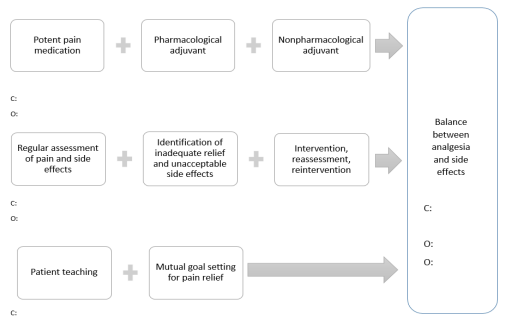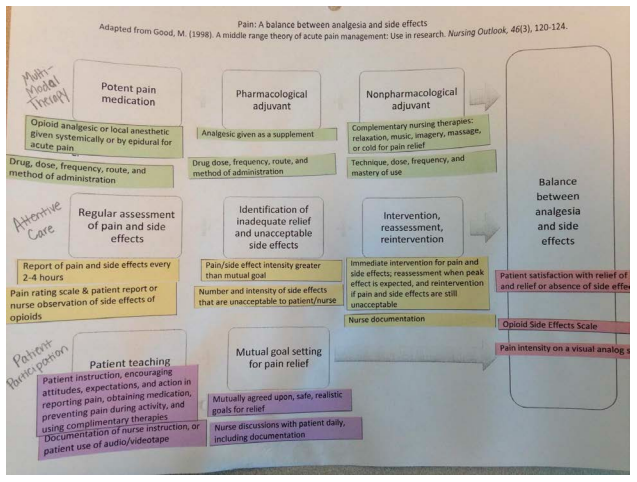6 Theory Mapping: Conceptual and Operational Definitions
| Prerequisite Knowledge |
|
| Learner Setting | Classroom |
| Strategy Type | Small group |
| Time | Faculty prep: 45 minutes
Delivery with students: 30 minutes Evaluation: 15 minutes |
| Learning Objectives |
|
| Materials/Resources | Map templates (see below)
Mapping pieces (see below) Envelopes Glue sticks Completed student example (see below) |
| Strategy Overview | After a brief instructor-generated example regarding the differences and connection between conceptual and operational definitions, students work in small groups to sort and place conceptual and operational definitions onto a map of a theory of pain. The instructor circulates the room to provide guidance and facilitates a discussion of the groups’ answers when the task is complete. |
| Steps |
|
| Evaluation | Low stakes – Instructor feedback during class activity and/or credit for active participation |
Theory Mapping: Instructor generated example
| Conceptual Definition | Operational Definition |
| The abstract or theoretical meaning of the concept being studies | The operations that researchers must perform to collect and measure the required information |
| Conceptual Definition | Operational Definition | |
| Weight | The gravitational pull on an object’s mass | An object’s weight in pounds, to the nearest whole pound |
| Anxiety | A feeling of unease | Hamilton Anxiety Rating Scale
Palmar Sweat Index |
Theory Mapping: Map template
Students glue conceptual definitions for each box beside (C) and operational definitions beside (O).

Adapted from Good, M. (1998). A middle range theory of acute pain management: Use in research. Nursing Outlook, 46(3), 120-124.
Theory Mapping: Mapping pieces
| Opioid analgesic or local anesthetic given systemically or by epidural for acute pain | Drug, dose, frequency, route, and method of administration |
| Analgesic given as a supplement | Drug dose, frequency, route, and method of administration |
| Complementary nursing therapies: relaxation, music, imagery, massage, or cold for pain relief | Technique, dose, frequency, and mastery of use |
| Report of pain and side effects every 2-4 hours | Pain rating scale & patient report or nurse observation of side effects of opioids |
| Pain/side effect intensity greater than mutual goal | Number and intensity of side effects that are unacceptable to patient/nurse |
| Immediate intervention for pain and side effects; reassessment when peak effect is expected, and reintervention if pain and side effects are still unacceptable | Nurse documentation |
| Patient instruction, encouraging attitudes, expectations, and action in reporting pain, obtaining medication, preventing pain during activity, and using complimentary therapies | Documentation of nurse instruction, or patient use of audio/videotape |
| Mutually agreed upon, safe, realistic goals for relief | Nurse discussions with patient daily, including documentation |
| Patient satisfaction with relief of pain and relief or absence of side effects | Pain intensity on a visual analog scale |
| Opioid Side Effect Scale |
Theory Mapping: Completed student example

